|
|
|
Petros Chassapoyannis(a), Serge Huberson (b), Spyros Voutsinas (a)
(a) National Technical University of Athens, Fluids Section,
P.O. Box 64070, 15710 Zografou, Athens, Greece
tel: (+)301-7721096, fax: (+)301-7721057, E-mail: aiolos@fluid.mech.ntua.gr
(b) University of Le Havre, Group for Energetics and Mechanics,
Quai Frissard, BP 540, Le Havre 76058, Cedex, France
tel: (+)33-35536937, fax: (+)33-35195715, E-mail: hu@psychose.cher.univ-lehavre.fr
2. REQUIREMENTS OF A DESIGN TOOL AND MODEL CAPABILITIES
During the last years, wind energy technology underwent substantial progress. A wider utilization of wind energy over Europe is under way and the industry will soon commercialise turbines much bigger than 0.5MW. In this course new challenging problems are set. Design optimisation at all levels so as to reduce costs even more, reduction of noise emissions, exploitation of wind energy at extreme sites (e.g. sites in complex terrains with high wind speeds) are some examples of such problems. So the need has emerged to revise the sufficiency of the existing design tools and possibly improving them or devising new.
2. REQUIREMENTS OF A DESIGN TOOL AND MODEL CAPABILITIES
Designing a wind turbine is a multi disciplinary and demanding work combining aeroelasticity, system control, electrical engineering etc. Tools for this purpose should include:
 A wind simulator valid also for non-flat terrains.
A wind simulator valid also for non-flat terrains.
 An aeroelastic model capable of predicting the response of the
wind turbine rotor to unsteady situations such as dynamic yaw,
fast gusts, dynamic stall etc.
An aeroelastic model capable of predicting the response of the
wind turbine rotor to unsteady situations such as dynamic yaw,
fast gusts, dynamic stall etc.
 A post processor for fatigue analysis.
A post processor for fatigue analysis.
Because wind turbines operate in an unfriendly environment, standards require from the designer to perform a long series of load cases before the machine is certified [1]. The amount of work required is high, so design tools must have low computational requirements which forces to make compromises. This is the reason why most existing design tools are based on simple engineering models which combine the blade element theory with the beam approximation.
Simple theories cannot model directly all the non-linearities included in the behaviour of a wind turbine. So they are supplied with external information such as the lift and drag characteristics of the airfoil sections, the beam equivalent characteristics of the blade, the S-N curves of the composite materials etc. Such additions have the disadvantage of suppressing to a large extent the interactions that take place in reality. It is difficult to decide which interactions are important and which can be neglected. Such questions can be bypassed in the design by increasing the safety factors. However, this contradicts the trend towards aerodynamically and structurally optimized rotors.
In order to investigate such aspects, laboratory and full scale experiments can be very helpful. They are however expensive and not always possible to carry out. Another way is to use advanced numerical models which in principle can reproduce physics in greater detail and so can help to better understand the underlying mechanisms. In aerodynamics free-wake 3D analysis is needed to simulate non-linear wake effects during dynamic inflow operation and stall. In fracture mechanics shell type theories must be used to check the prediction of stresses in composite stacking sequences. In this connection joint research work was carried out within several Joule projects: the two "Dynamic Inflow" projects [2,3], the project on Dynamic Stall and 3D Effects [4], the NEWDESI project [5], the REFSTRESS project [6] and other at a European or National level. As a result, the engineering models were improved substantially, new more elaborate models were devised and above all extensive validations were performed for old and new models over a wide range of different wind turbines. Thus a data base has been constructed which gives a clear image of the current situation.
3. ADVANCED DESIGN TOOLS AND CURRENT STATE OF ART
Reviewing the current state of art, the basic facts for each of the three main parts of a design tool are as follows:
In terms of aerodynamics, dynamic inflow effects were extensively studied by using vortex particle free-wake modelling (GENUVP). This work resulted detailed information on the unsteady velocity field in the wake (Figure 1). Being confident to these predictions, an improved blade element model was devised (RAFT) by adding an unsteady term in the momentum equation and by correcting the expression of the axial induced velocity in case of yaw misalignment [7]. The goal was to quantify the effects on the induced angle of attack so as to get correct loads.
The main draw back of blade element models is their strong dependence on airfoil data. Several attempts have been made to alleviate this disadvantage but there is still lack of cost effective models that can perform well over the whole range of wind speeds and for different operational conditions. In this connection an intermediate model was developed using a semi-prescribed wake geometry (LSURF) [8]. Again the free-wake predictions were used to finalize the model. LSURF has reasonable computational demands and for attached flows it does not need any external data. In terms of predictions it can provide results of the same quality as the blade element model (Figures 2, 3).
At high wind speeds however, where stall makes its appearance, only semi-empirical models exist such as the Leishmann or the ONERA models. Recently a double wake approach using vortex particles was successfully tested in 2 and 3D flows [9] (Figure 4). However its high computational requirements, makes it impossible to use it otherwise but as a research tool.
As regards the structural modelling, the beam approximation proved to be a good compromise. A possible alternative would be a shell type model. Comparisons reported in [10] suggest that the detail offered by a shell model could be necessary only in cases where shear stresses become important (Figure 5). Thus in case of more flexible constructions where large deformations can appear, the validation of the beam approximations should be repeated.
There exist two models one by Veers and one by Mann. Mann's model is a three component model which was recently extended to non-flat terrains [11]. On the other hand, Veers' model [12] although in principle capable of including three component modelling, this has not yet been reported, basically due to lack of sufficient information on cross correlations. For flat terrain applications both models can be trusted [13]. In complex terrain applications although work is currently in progress [14], there is not yet a definite answer as to which is the best way to model turbulent winds.
In this connection little is known for sure. The first serious attempt to synthesize the available information on the subject was published only very recently [15]. On fatigue analysis, in REFSTRESS [6] indications are given on a possible procedure which is by no means final.
Based on the results obtained over the last three years with different computational tools, ranging from engineering models as RAFT up to 3D free-wake flow modelling using particles (GENUVP), it follows that in most cases and of course when there are no strong non-linearities, the improved engineering models can be reliable. However, three aspects of the whole procedure need further research as there are still open questions. These aspects are:
 The modelling of stall.
The modelling of stall.
 The three-component simulation of turbulent winds including
terrain effects.
The three-component simulation of turbulent winds including
terrain effects.
 The fatigue analysis of composite blades.
The fatigue analysis of composite blades.
Advanced models such as free-wake aerodynamic analysis and shell-type structural modelling are important for calibrating and cross checking simpler models.
This work was partially financed by the CEU under various contracts: JOUR-0083, JOU2-CT92-0186 ("Dynamic Inflow" projects), JOU2-CT92-0113 ("NEWDESI" project), JOU2-CT93-0345 ("DS3D" project), JOU2-CT93-0378 ("MOUNTURB" project) and by the Greek General Secretariat for Research and Technology under the EPET-II#573 contract. We would like to thank all the colleagues from the different projects for providing valuable information and discussion, particularly Dr R.Hales (Cranfield Institute of Technology), Mr G.Scheppers (ECN), Dr T.Philippidis (University of Patras), Dr A.Fragoulis, Dr V.Morfiadakis and Mr P.Vionis (CRES).
[1] IEC International Standard, CEI/IEC 1400-1 (1994).
[2] Snel H., Schepers J.G., ECN-C-94-107 (1995).
[3] Scheppers J.G., Snel H., ECN-C-95-056 (1995).
[4] Bjorck A., FFA TN 1995-31 (1995).
[5] Voutsinas S.G., Final Rep. JOU2-CT92-0113 (1995).
[6] Grol van H.J., Bulder B.H., ECN-C-94-013 (1994).
[7] Katopis K.G., Voutsinas S.G., "RAFT: A Rotor Analysis Fast Tool" NTUA Rep. (1996).
[8] Chassapoyannis P.I., Rawlinson-Smith R., Voutsinas S.G., Proc.EWEC'94, (1994).
[9] Voutsinas S.G, Riziotis V., Proc. ASME Symposium on Vortex Flows and Vortex Methods (1996).
[10] Philippidis T.P., Vassilopoulos A. Katopis K.G. Voutsinas S.G. "PROBEAM: a software for fatigue design and analysis of composite rotor blades" in preparation (1996).
[11] Mann J., Riso-R-727(EN) (1994).
[12] Veers P.S., SAND880152 (1988).
[13] Kretz A., Madsen H.A., Petersen J.T., Riso-R-671(EN) (1994).
[14] Fragoulis A., 4th Prog.Rep. JOU2-CT93-0378 (1996).
[15] Kensche C.W., EUR-16684 (EN) (1996).
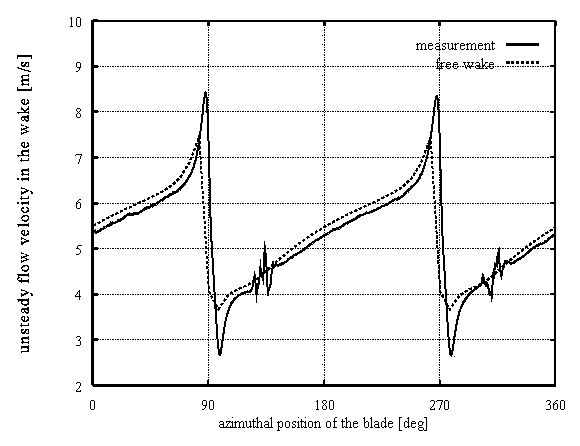 (a)
(a)
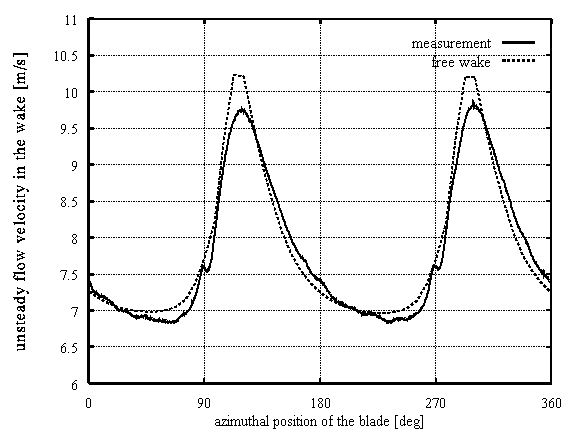 (b)
(b)
Figure 1: DUT rotor. TSR=6, velocity time traces in the wake at x/R=0.053 downstream the rotor and at radial positions (a) y/R=0.8, (b) y/R=1.05.
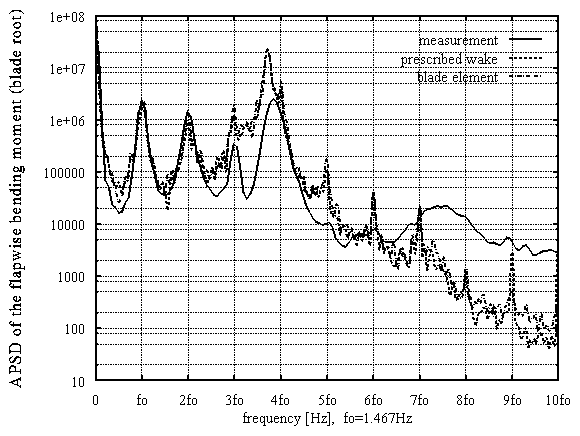
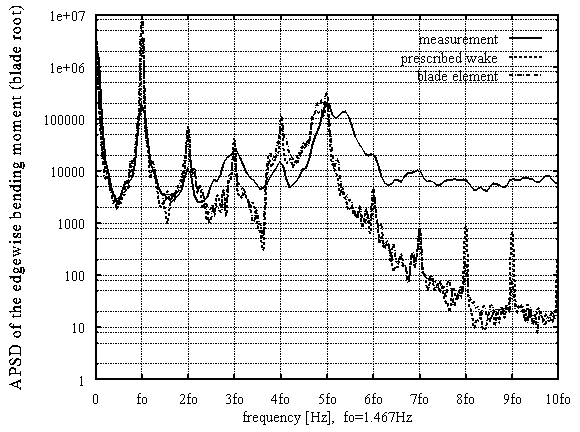
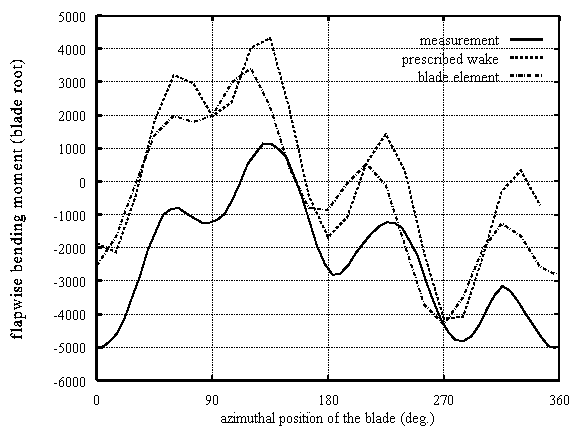
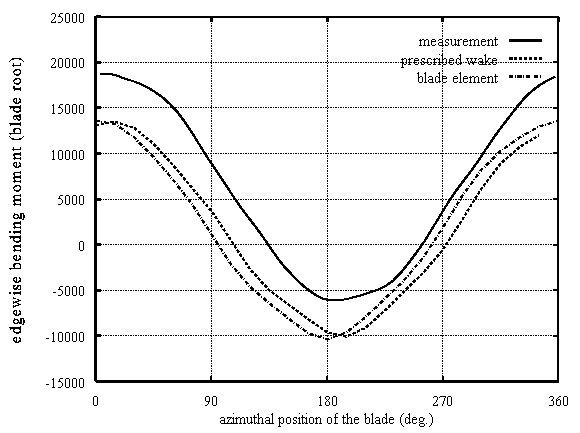
Figure 2: WEG-MS1 rotor. Turbulent inflow case: Uwind=10.23m/s, yaw=-18o, T.I.=18%, aerodynamic tower effects are included, blade passes in fl\ront of the tower at 180 deg . Spectra and binned values for the flapwise and edgewise bending moments at the blade root.
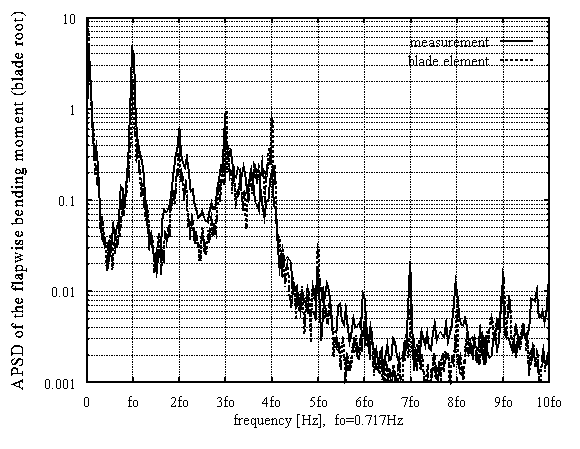
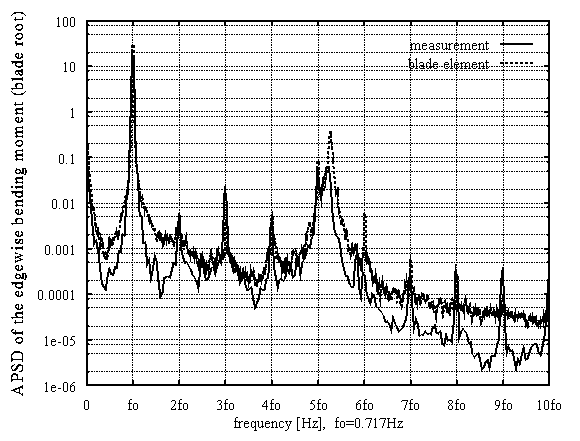
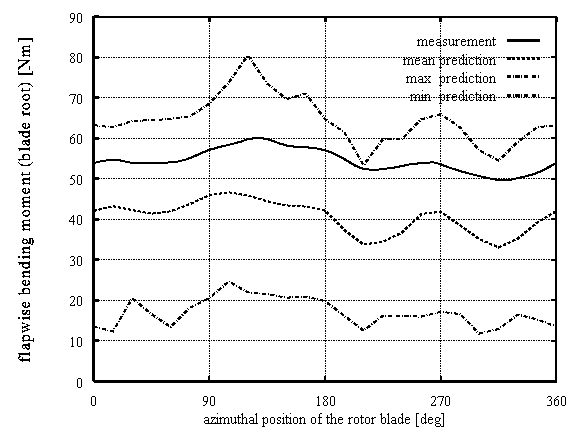
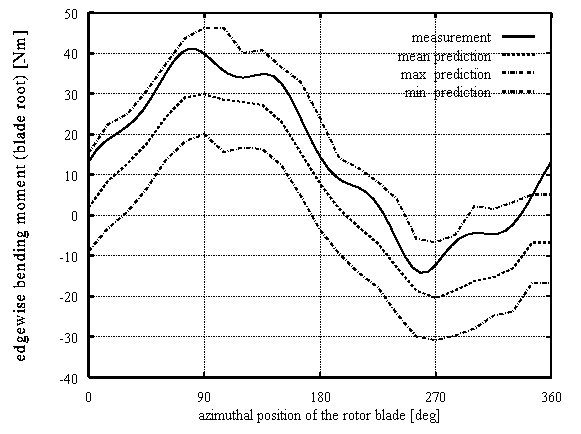
Figure 3: VESTAS V27 rotor. Uwind=14m/s, T.I.=15%, no yaw, almost vertical shear, aerodynamic tower effects. Spectra and binned values for the flapwise and edgewise bending moments at the blade root.
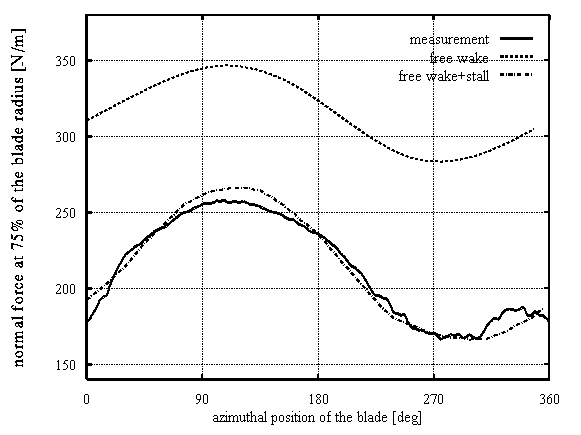
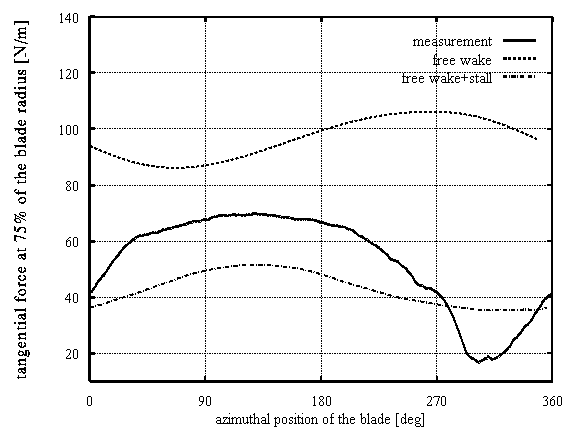
Figure 4: Cranfield rotor. Uwind=21.4m/s, yaw=15o, (blade passes in front of the tower at 270o)
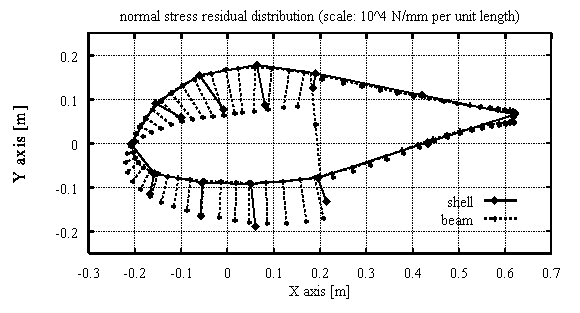
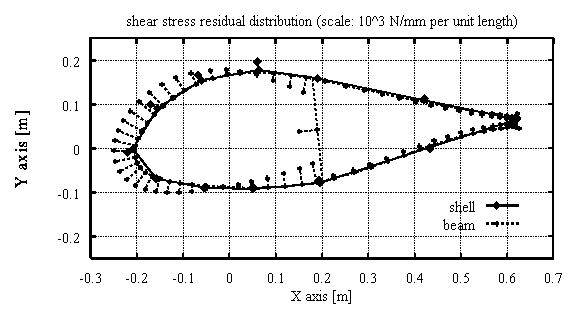
Figure 5: Normal and shear stress predictions from shell and beam models in the case of a given airfoil section.
|
|
|
|
|
|